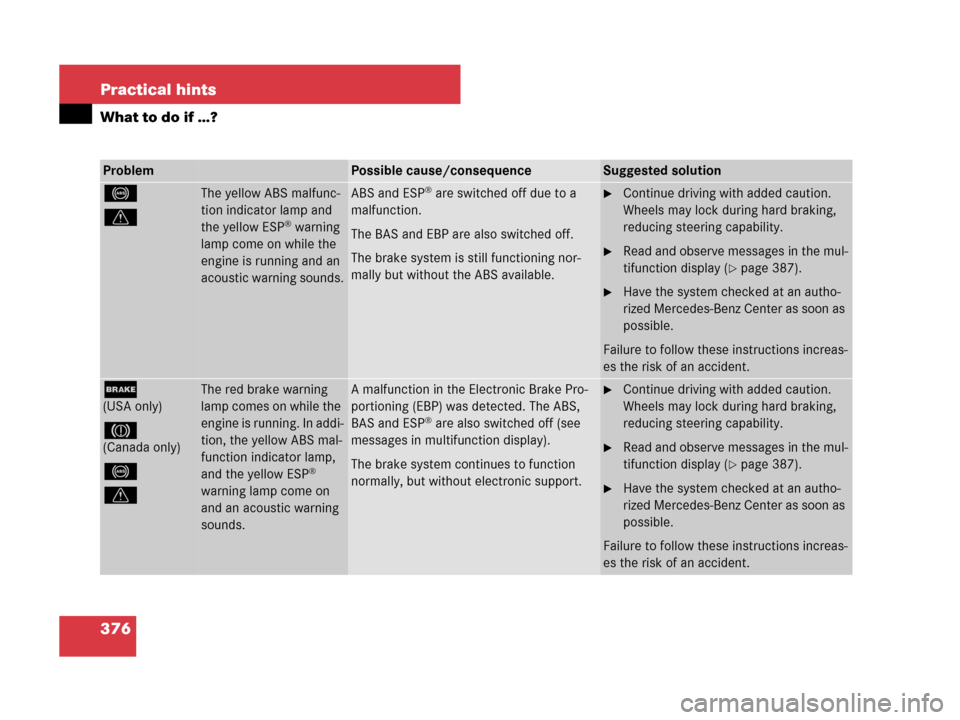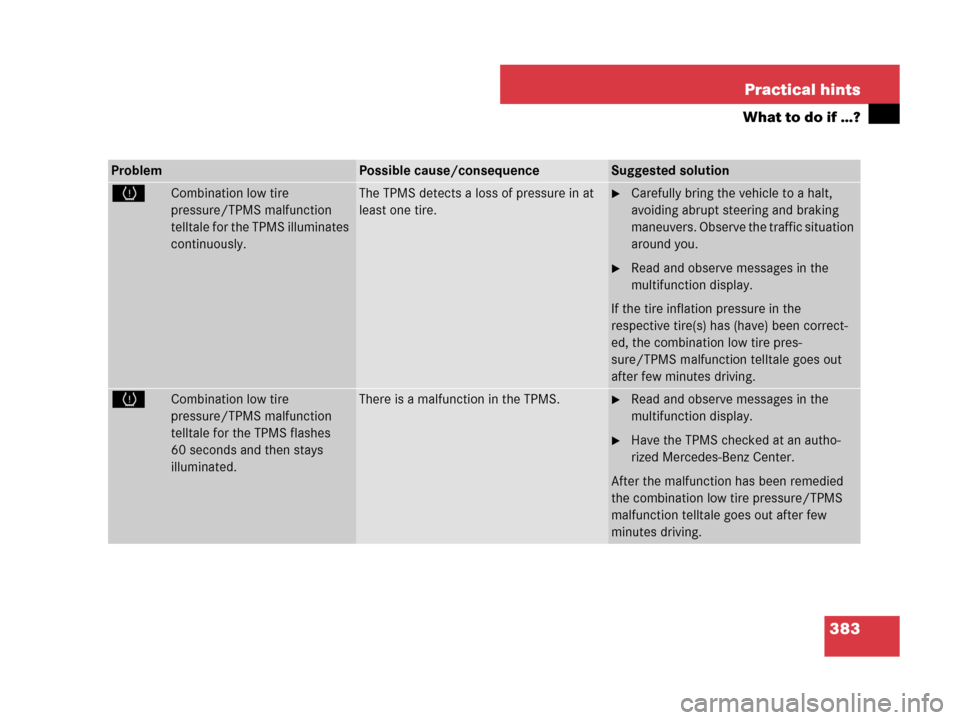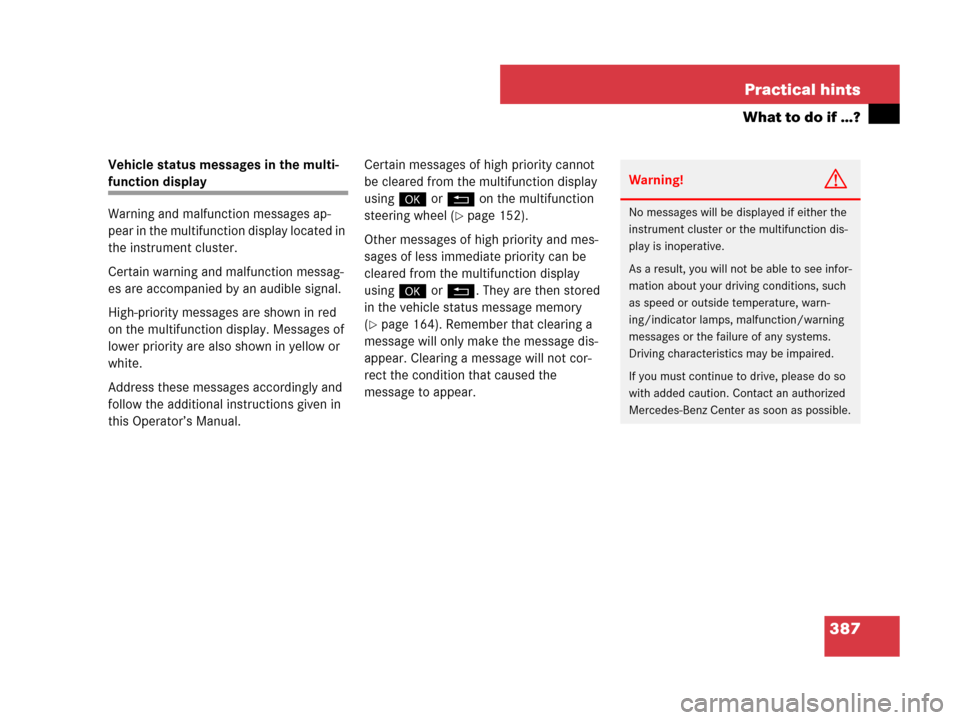Page 371 of 509

370 Operation
Vehicle care
Light alloy wheels
If possible, clean wheels once a week.
�Use Mercedes-Benz approved Wheel
Care, a soft bristle brush and a strong
spray of water for cleaning the light al-
loy wheels.Plastic and rubber parts
�Use a gentle dishwashing detergent or
mild detergent for delicate fabrics as a
washing solution.
�Wipe with a cloth moistened in a luke-
warm solution.
The surface may temporarily change
color. If this is the case, wait for it to
dry.Hard plastic trim items
�Use Mercedes-Benz approved Interior
Care, a soft, lint-free cloth and apply
with light pressure.
!Only use acid-free cleaning materials. Acid
may cause corrosion or damage the clear coat.
!The vehicle should not be parked for an
extended period of time immediately after it has
been cleaned, especially not after the wheel rims
have been cleaned with wheel rim cleaner.
Wheel rim cleaners can lead to increased
corrosion of the brake disks and brake pads.
Non-approved wheel cleaners may also damage
the wheel paint if the car is not driven after
cleaning.
Therefore, the vehicle’s brake system should al-
ways be warmed-up before it is parked after
cleaning. To do so, please drive your vehicle for
several minutes to allow the brakes to dry. When
applying Mercedes-Benz approved Tire Care and
Mercedes-Benz approved Wheel Care products,
take care not to spray them on the brake disks.
Warning!G
Do not use cleaners or cockpit care sprays
containing solvents to clean the cockpit or
the steering wheel. Cleaners containing sol-
vents will make the surface porous and vehi-
cle occupants could suffer serious injuries
from plastic parts coming loose in the event
of air bag deployment.
!Do not use oil, wax or scouring agents on
these parts.
Never apply strong force and only use a soft,
non-scratching cloth when cleaning the surface.
Do not attempt to wipe the surface with a dry
cloth or sponge.
Otherwise you may scratch or damage the sur-
face.
!Never apply strong force and only use a soft,
non-scratching cloth when cleaning the surface.
Do not attempt to wipe the surface with a dry
cloth or sponge.
Otherwise you may scratch or damage the sur-
face.
Page 372 of 509

371 Operation
Vehicle care
Audio display
�If you need to clean the audio display
screen, use a standard microfiber cloth
and cleaning agent for TFT/LCD dis-
plays. After cleaning, dry and polish the
screen with a dry microfiber cloth.Steering wheel
�Wipe with a damp cloth and dry thor-
oughly or clean with Mercedes-Benz
approved Leather Care.
Carpets
�Use Mercedes-Benz approved Carpet
and Fabric Care for cleaning the car-
pets.Headliner and shelf below rear window
�Use a soft bristle brush or a dry-sham-
poo cleaner in case of excessive dirt.
Seat belts
�Only use clear, lukewarm water and
soap.
!You must switch off the audio display and al-
low it to cool prior to cleaning.
!Do not use thinners containing alcohol,
petrol or abrasive cleaning agents. These can
damage or even destroy the audio display
screen.
!The webbing must not be treated with
chemical cleaning agents. Do not dry the web-
bing at temperatures above 176°F (80°C) or in
direct sunlight.
Warning!G
Do not bleach or dye seat belts as this may
severely weaken them. In a crash they may
not be able to provide adequate protection.
Page 375 of 509

374 Practical hints
What to do if …?
Lamps in instrument cluster
General information:
If any of the following lamps in the instru-
ment cluster fails to come on during the
bulb self-check when switching on the igni-
tion, have the respective bulb checked and
replaced if necessary.
ProblemPossible cause/consequenceSuggested solution
-The yellow Antilock
Brake System (ABS)
indicator lamp comes on
while the engine is
running.The ABS has detected a malfunction and
has switched off. The BAS, ESP® and EBP
are also switched off (see messages in mul-
tifunction display).
The brake system is still functioning nor-
mally but without the systems specified
above.
If the ABS control unit is malfunctioning,
other systems such as navigation system*
or the automatic transmission* may also be
malfunctioning.
�Continue driving with added caution.
Wheels will lock during hard braking, re-
ducing steering capability.
�Read and observe messages in the mul-
tifunction display (
�page 387).
�Have the system checked at an autho-
rized Mercedes-Benz Center as soon as
possible.
Failure to follow these instructions
increases the risk of an accident.
Page 377 of 509

376 Practical hints
What to do if …?
ProblemPossible cause/consequenceSuggested solution
-
vThe yellow ABS malfunc-
tion indicator lamp and
the yellow ESP
® warning
lamp come on while the
engine is running and an
acoustic warning sounds.
ABS and ESP® are switched off due to a
malfunction.
The BAS and EBP are also switched off.
The brake system is still functioning nor-
mally but without the ABS available.�Continue driving with added caution.
Wheels may lock during hard braking,
reducing steering capability.
�Read and observe messages in the mul-
tifunction display (
�page 387).
�Have the system checked at an autho-
rized Mercedes-Benz Center as soon as
possible.
Failure to follow these instructions increas-
es the risk of an accident.
;
(USA only)
3
(Canada only)
-
v
The red brake warning
lamp comes on while the
engine is running. In addi-
tion, the yellow ABS mal-
function indicator lamp,
and the yellow ESP
®
warning lamp come on
and an acoustic warning
sounds.
A malfunction in the Electronic Brake Pro-
portioning (EBP) was detected. The ABS,
BAS and ESP
® are also switched off (see
messages in multifunction display).
The brake system continues to function
normally, but without electronic support.
�Continue driving with added caution.
Wheels may lock during hard braking,
reducing steering capability.
�Read and observe messages in the mul-
tifunction display (
�page 387).
�Have the system checked at an autho-
rized Mercedes-Benz Center as soon as
possible.
Failure to follow these instructions increas-
es the risk of an accident.
Page 384 of 509

383 Practical hints
What to do if …?
ProblemPossible cause/consequenceSuggested solution
HCombination low tire
pressure/TPMS malfunction
telltale for the TPMS illuminates
continuously.The TPMS detects a loss of pressure in at
least one tire.�Carefully bring the vehicle to a halt,
avoiding abrupt steering and braking
maneuvers. Observe the traffic situation
around you.
�Read and observe messages in the
multifunction display.
If the tire inflation pressure in the
respective tire(s) has (have) been correct-
ed, the combination low tire pres-
sure/TPMS malfunction telltale goes out
after few minutes driving.
HCombination low tire
pressure/TPMS malfunction
telltale for the TPMS flashes
60 seconds and then stays
illuminated.There is a malfunction in the TPMS.�Read and observe messages in the
multifunction display.
�Have the TPMS checked at an autho-
rized Mercedes-Benz Center.
After the malfunction has been remedied
the combination low tire pressure/TPMS
malfunction telltale goes out after few
minutes driving.
Page 388 of 509

387 Practical hints
What to do if …?
Vehicle status messages in the multi-
function display
Warning and malfunction messages ap-
pear in the multifunction display located in
the instrument cluster.
Certain warning and malfunction messag-
es are accompanied by an audible signal.
High-priority messages are shown in red
on the multifunction display. Messages of
lower priority are also shown in yellow or
white.
Address these messages accordingly and
follow the additional instructions given in
this Operator’s Manual.Certain messages of high priority cannot
be cleared from the multifunction display
using# or L on the multifunction
steering wheel (
�page 152).
Other messages of high priority and mes-
sages of less immediate priority can be
cleared from the multifunction display
using# or L. They are then stored
in the vehicle status message memory
(
�page 164). Remember that clearing a
message will only make the message dis-
appear. Clearing a message will not cor-
rect the condition that caused the
message to appear.
Warning!G
No messages will be displayed if either the
instrument cluster or the multifunction dis-
play is inoperative.
As a result, you will not be able to see infor-
mation about your driving conditions, such
as speed or outside temperature, warn-
ing/indicator lamps, malfunction/warning
messages or the failure of any systems.
Driving characteristics may be impaired.
If you must continue to drive, please do so
with added caution. Contact an authorized
Mercedes-Benz Center as soon as possible.
Page 390 of 509

389 Practical hints
What to do if …?
Text messages
Display Possible cause/consequencePossible solution
ABS and ESP
Currently Unavailable
See Operator’s ManualABS and ESP® are not available due to a malfunction.
BAS and the hill start assist are also switched off. It
is possible that the self-diagnostics have not yet
been completed.
The brake system still functions normally.�Drive a short distance with gentle turns above a
speed of 12 mph (20 km/h).
The message disappears when ABS and ESP
®
are again available.
The ABS and ESP® were deactivated because of in-
sufficient power supply. The charging voltage has
fallen below 10 volts. BAS and the hill start assist are
also deactivated.
The brake system still functions normally but without
the ABS and ESP
® available.
When the voltage is above this value again, the ABS
and ESP® are operational again and the message in
the multifunction display should disappear.
If the message in the multifunction display does not
disappear:
�Have the generator (alternator) and the battery
checked.
ABS and ESP
Inoperative
See Operator’s ManualABS and ESP® are switched off due to a malfunction.
BAS and the hill start assist are also switched off.
The brake system still functions normally but without
the ABS and ESP
® available.
�Continue driving with added caution. Wheels
may lock during hard braking, reducing steering
capability.
�Have the system checked at an authorized
Mercedes-Benz Center as soon as possible.
Failure to follow these instructions increases the
risk of an accident.
Page 392 of 509
391 Practical hints
What to do if …?
Display Possible cause/consequencePossible solution
Check
Tire Pressure Soon
(Canada only)
The Run Flat Indicator indicates that the
pressure is too low in one or more tires.�Carefully bring the vehicle to a halt, avoiding abrupt steering
and braking maneuvers. Observe the traffic situation around
you.
�Check and adjust the tire inflation pressure as required
(
�page 339).
�If necessary, change the wheel (�page 440).
�Restart the Run Flat Indicator after adjusting the tire inflation
pressure values (
�page 343).
Warning!G
Do not drive with a flat tire. A flat tire affects
the ability to steer or brake the vehicle. You
may lose control of the vehicle. Continued
driving with a flat tire will cause excessive
heat build-up and possibly a fire.